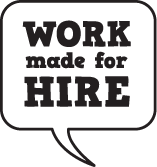Power Couples
I’m always excited when I hear that artists I admire are collaborating on a new project. Collaboration — in art or other ventures — lends you a perspective you can’t have on your own, and because of that it can produce some exceptionally cool results.
But just because a collaboration can produce wonderful things, it doesn’t mean the road to creation is smooth and pothole free. While I can’t help with the creative dips and bumps, I can tell you how to avoid some common collaboration conflicts and deal with the ones you can’t avoid.
Know Thyself
Some people hate background noise when they work (me), except noise they make themselves (me), or noise they can’t hear because they are throwing down some mad spreadsheet skills (also me). Others will filp out when forced to endure a quiet room for more than 30 seconds.
Everybody works well in certain conditions and would trade their firstborn to avoid others.
Know yourself and your limitations.
Don’t set yourself up for disappointment by entering collaborations that set off all your work preference triggers before work even starts. If your potential collaborator is well known for being late on deadlines and works best from 5 am to noon, while you are a punctual night owl, don’t kid yourself that your working styles will “figure themselves out.”
But what if you still really really really want to work with this person youaresureitwillbeokhonest? Pick something with low stakes that will be fun but if everything goes all wrong it won’t impact things you care about — like food, shelter and a decent reputation. You can use the smaller project to test things out and see if a bigger collaboration is in the cards.
Unless your collaborator is a mind reader (and even if they are), let him or her about all your work tics — that you prefer phone calls over emails, that you’re most productive between 10 pm and 3 am, that you have a deep resentment of the color mauve.
Sharing this information helps avoid conflict, and when conflict does happen, because it will, it gives you a place to start the conversation. Instead of the totally out of the blue “Your twitter stream is driving me mad, Jeremy; mad!” you can refer back to these initial conversations and how the tweeting is triggering that fear of jinxing the project you talked so much about.
For some more ideas on what to talk about and how to start these beginning conversations, check out this post. It provides an exercise you and your collaborator can do to help facilitate what can be an awkward conversation.
Regular, Special, Fast
Now that you’ve talked about your tics and tested the waters to make sure working together won’t drive either one of you to set a car on fire, you need to: schedule some meetings!!!!1
What?
These are special meetings; they aren’t meetings about TPS Reports and Mandatory Casual Fridays. These meetings are about your collaboration, what’s going well, what’s coming up and what might need tinkering. You’ll like these meetings, I promise.
They can happen whenever and wherever you want; they can have agendas or follow your whim. The only thing the meetings have to be are: regular, special and fast.
Regular— Most people avoid conversations about how things are going in the collaboration, not because they don’t have something they want to

(c) Walt Disney Company
say, but because they don’t know how to bring it up. Do both of yourselves a favor and set up a regular time where you meet and talk about how the collaboration is working out. Are you meeting deadlines? Did the quote come back from the supplier? Is the girl from the party last week going to keep calling the studio?
Setting up a time to chat on a regular basis, every other Thursday, Sundays at noon, will make conversations about the collaboration more common. That means that when there is something of significance to talk about, you can focus on the issue and not “Why the hell do we need a meeting?”
Special — When you have your meetings, avoid the temptation to talk about last week’s Game of Thrones episode or whatever fight the internet is having with itself that day. This time is special — it’s for talking about the project and your collaboration.
One of the many benefits of making the meeting about the collaboration and nothing else, is that you’ll both be primed to hear and share information about how it’s working. When there is a lot of tangential noise in a conversation, especially noise that is fun, it makes it harder to pay attention to the reason you sat down to talk in the first place.
Fast — These meetings should not take very long; they shouldn’t take up so much time you feel like it’s robbing you from work time. As long as they are regular and special, they can be five whole minutes long and still be incrediby helpful.
An easy way of making the meetings fast is for each of you to complete the following sentences:
- Things that are working well for me right now are________________________.
- Things that I need some help with are_________________________________.
- I’m excited about__________________________________.
- I’m worried about_________________________________.
Filling in the blanks will give your collaborator a lot of helpful information. It can also help keep the meeting short, sweet and to the point.
Great, But What if I’m in the Middle of a Collaboration?
These can be helpful ideas if you’re just starting out a collaboration, but what if you’re in the midst of one and you’ve run into some problems?
For instance, when you started the project you didn’t talk about money, but now you are really strapped for cash, you’ve been offered a conflicting paying gig and you just read this post about not working for free.

(c) BBC
What you should not do is unilaterally decide what needs to happen in the collaboration as the result of your worry. Making unilateral decisions about what should and shouldn’t happen in a collaboration defeats the purpose of having a collaboration.
Instead, call or meet with your collaborator and tell them that you have a concern that might impact the project and you want to figure out what to do about it. Now, the decision you need to make might very well be taking that paying job, and you can make that decision without asking for permission from anyone. But how your taking the paying job will impact the project needs to be a decision you make with your collaborator.
If your collaborator is the one making the unilateral decision, you need to be the one to call for a conversation. Tell them you respect their need for paying work, and you both need to be involved in making a decision about how will that impact the collaboration.
Once you’ve had that tough conversation, suggest a bit of a refresh. Maybe it’s time to have those conversations you didn’t have at the beginning, or have them again to see if anything’s changed. Then set up a regular time to talk about the project so neither one of you is left in the dark about something again.
Collaborations can be awesome experiences that let you create in ways you’d never have imagined. Take the time to invest in a bit of relationship work up front and you can spend more time making cool things with cool people.
Featured image (c) Mr. Bill Watterson, to whom I am thankful for many delightful afternoons spent pondering the universe.
Categories: Dealing with People




